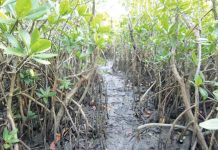The government further enhanced its efforts this year to build climate resilience among communities nationwide and address climate change to better protect the environment, lives and property.
In April, the government finally submitted to the United Nations Framework Convention on Climate Change (UNFCCC) Secretariat the Philippines’ first nationally determined contribution (NDC) which covers planned reduction of greenhouse gas (GHG) emissions in the country.
This signified the commitment of the Philippines, a UNFCCC party, to help meet the Paris Agreement’s goal of limiting global temperature rise through GHG emission reduction worldwide so Earth can avoid dangerous climate change.
At the UN’s 26th Conference of the Parties (COP26) in Scotland in November, the Philippine government also reiterated its call for climate justice and developed countries’ financial and technical support for climate initiatives of developing nations.
The government likewise reconstituted the National Panel of Technical Experts (NPTE) of Climate Change Commission (CCC) and focused this group’s thrust on generating recommendations for implementing local climate change adaptation and mitigation measures that will help build communities’ resilience.
“We have drawn up a Sustainable Finance Roadmap to help orchestrate public and private sector efforts to green our economy,” Department of Finance (DOF) Sec. and CCC Chairperson-designate Carlos Dominguez III also said in his 2021 message for the country’s annual Global Warming and Climate Change Consciousness Week observance.
He raised the urgency for action, noting climate change “is a battle we cannot afford to lose.”
The devastation caused by the onslaught of extreme weather events already gave a preview of what inaction on climate change can lead to, he said.
According to experts, various human activities like fossil fuel-based power generation are among sources of GHG emissions.
They said GHG emissions continue accumulating in the atmosphere and trapping heat so global temperature is rising, changing climate.
The NPTE identified the Philippines’ top climate-induced risks as rising sea level, coastal erosion, flooding, increasing frequency and severity of tropical cyclones, extreme drought, temperature increase and rising urban heat index, extreme rainfall, climate-influenced diseases, wind patterns and biodiversity loss, the DOF said.
It also said NPTE recommended several measures for dealing with such risks.
Among such measures are conducting nationwide climate and health impact assessments and including climate finance in LGUs’ investment and development plans, the DOF said.
Experts said the Philippines accounts for less than 1 percent of global GHG emissions so this country is not a major source of these discharges.
Through its NDC, however, the Philippines still committed 75 percent GHG emission reduction and avoidance nationwide by 2030 in the agriculture, waste, industry, transport, and energy sectors.
Of such target, the government said 2.71 percent will be implemented mainly through domestic resources.
The government also said the target’s remaining 72.29 percent is conditional or contingent upon climate finance, technologies, and capacity development which developed countries are expected to provide in accordance with Paris Agreement.
“We expect that developed nations, which historically caused the global climate crisis, will deliver their commitments to Paris Agreement with the right speed and scale to keep global average temperature from breaching the 1.5 degrees Celsius survival threshold,” Dominguez said.
He considers the present time until 2030 “critical”, noting this period is an opportunity to undertake low-carbon and resilient development as well as other climate action that’ll ensure Earth’s well-being “before it’s too late.” (PNA)



